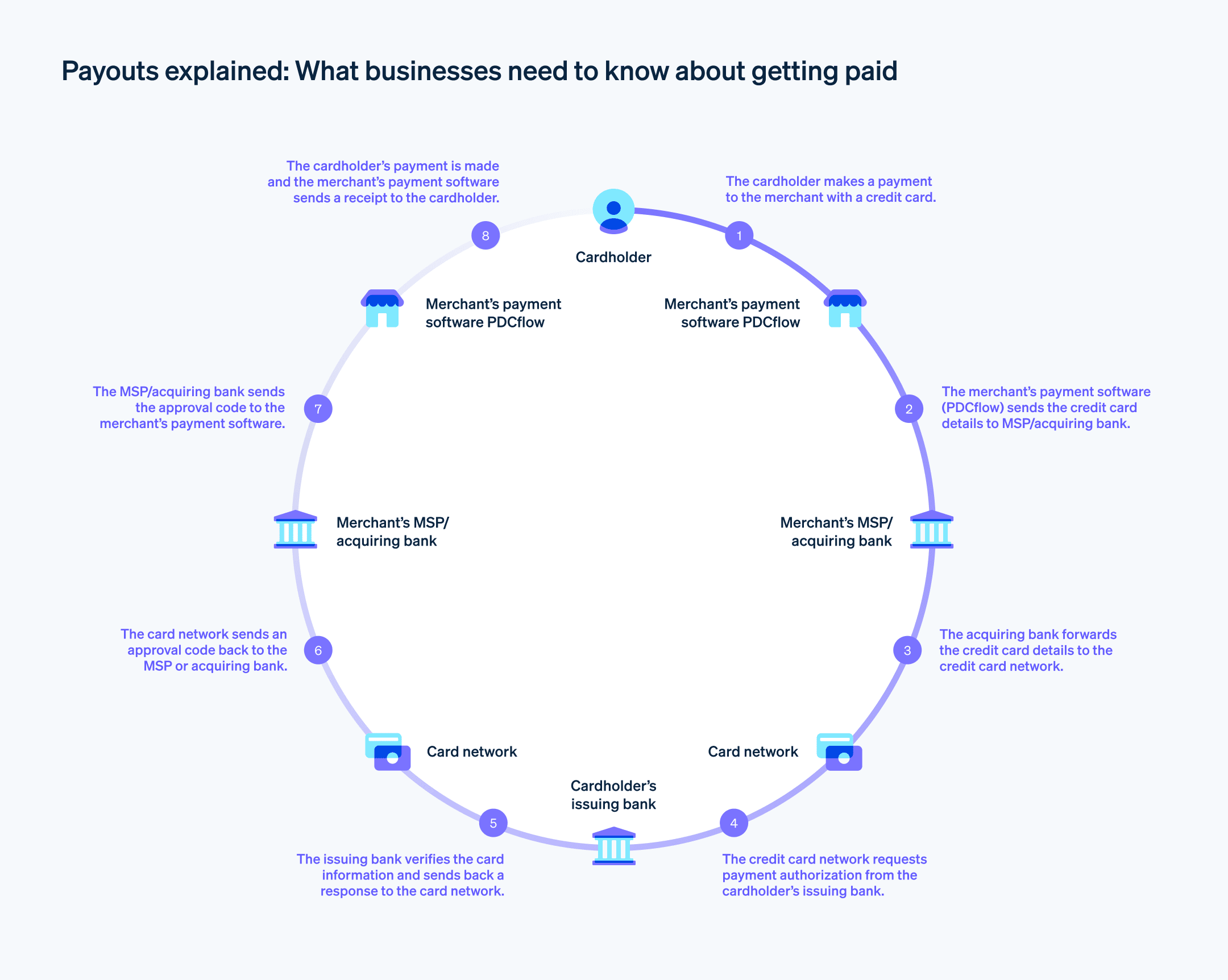随着客户支付偏好的不断变化,企业必须调整其支付处理系统以保持竞争力。通过深思熟虑地构建信用卡处理系统,企业可以改善客户体验、简化运营并获得新的增长机会。
不正确地设置信用卡支付处理系统可能会导致额外的成本、运营效率低下,并且更容易发生付款欺诈。了解信用卡交易处理的运作方式以及如何设置信用卡处理系统非常重要。以下是您需要了解的内容。
目录
- 什么是信用卡交易处理?
- 信用卡交易处理:关键组成部分
- 信用卡交易处理如何运作?
- 企业的信用卡交易处理成本
- 为什么信用卡交易处理对企业很重要?
什么是信用卡交易处理?
当涉及信用卡的电子交易在持卡人、企业及其各自的金融机构之间进行授权、认证和结算 时,就会发生信用卡处理。通过这一流程,企业可以接受商品或服务的信用卡付款,从而让企业和客户的交易过程轻松便捷。
信用卡交易处理:关键组成部分
虽然信用卡交易的处理速度通常非常快,但背后的过程却很复杂。该过程需要许多相互协作的组件,以确保资金安全有效地流动。
以下是参与此过程的各方的概述:
持卡人
持卡人是拥有信用卡并用其购买商品或服务的个人。商家
商家是接受客户的信用卡付款以换取商品或服务的企业或服务提供商。支付网关
支付网关是一种在企业的 POS 系统和信用卡处理商之间安全地传输交易信息的服务。卡组织
Visa、Mastercard、American Express 和 Discover 等卡组织促进了信用卡处理商和发卡行之间的通信,并制定了交易规则和标准。发卡行
发卡银行也称为“发卡机构”或“发卡行”,是向持卡人发行信用卡的金融机构。它授权和批准交易,并为购物提供资金。收单行
收单行 也称为“收单行”或“商家银行”,是与企业有合同关系以接受和处理信用卡交易的金融机构。它与发卡行结算资金并将资金存入企业账户。
信用卡交易处理如何运作?
信用卡交易处理因交易发生地点和使用的卡类型而异。例如,线上信用卡交易的发起方式与线下卡交易不同。同样,客户将信用卡存储在数字钱包 中的线下交易与客户使用实体卡的线下交易相比,运作方式也会有所不同。
不过,即使存在这些较小的差异,整个信用卡交易流程在不同类型的交易中也基本一致。下文简要介绍了该流程的运作方式:

1. 发起
持卡人向企业提供其信用卡信息。对于线下交易,这意味着刷卡、插入 或触碰 他们的卡。对于线上交易,这意味着手动输入银行卡详细信息或从存储的支付方式中选择银行卡。
2. 数据传输
企业的 POS 系统或支付网关捕获交易详细信息,并将此信息安全地传输到信用卡处理商。
3. 授权请求
信用卡处理商将交易数据转发到相应的卡组织,然后由卡组织将授权请求路由到发卡行。
4. 批准或拒绝
发卡行会验证持卡人的账户,检查资金是否充足,以及是否有任何潜在的欺诈或安全问题。根据这一评估,银行要么批准交易,要么拒绝 交易,并将此决定传达给卡组织,卡组织将该信息转发给信用卡处理商。
5. 授权响应
信用卡处理商将授权响应(批准或拒绝代码)发送到企业的 POS 系统或支付网关。如果交易获得批准,企业就可以完成销售并向客户提供商品或服务。
6. 结算
在一天结束时,企业将所有已批准交易的批次提交给信用卡处理商进行结算。处理商还会将交易详细信息转发给相应的卡组织。
7. 资金转账
卡组织与发卡行协调,将每笔交易的资金转给收单银行,收单银行在商家账户 中接收资金。然后,收单银行将资金转入企业的常规商业银行账户,减去任何手续费。整个过程通常需要 1-3 个工作日。
8. 持卡人账单
发卡行将交易金额添加到持卡人的账户余额中,并将其计入月度对账单。持卡人有责任根据其信用卡协议的条款和条件支付信用卡账单。
企业的信用卡交易处理成本
信用卡交易处理成本可能因信用卡类型、交易量和单个支付处理商而异。企业需要了解这些成本,以便做出明智的决策并更大限度地减少支付处理费用。
以下是信用卡交易处理成本的主要类型:
交换费
持卡人的发卡行对每笔信用卡交易收取交换费。交换费通常是交易金额的百分比,加上固定的每笔交易费。确切的交换费取决于卡的类型、企业所属的行业以及卡在交易中的使用方式;例如,客户是刷信用卡还是手动输入卡信息。评估费
卡组织通常对其支付基础设施的使用收取评估费。这些费用通常只占交易金额的一小部分,并且可能因卡组织和交易量而异。处理商加价
信用卡处理商和商家服务 提供商对其服务收取加价费,这些服务包括处理授权、结算以及与卡组织和银行的通信。此加价可以是交易金额的百分比、每笔交易费用或月费。有关 Stripe 费用结构的信息,请点击此处。支付网关费用
对于线上交易,企业可能需要使用支付网关,该网关在企业网站和信用卡处理商之间安全地传输交易信息。通常,支付网关提供商对其服务收取月费或每笔交易费。终端和设备费
企业可能需要投资购买 POS 终端、读卡器或其他设备来接受信用卡付款。这些费用可能包括购买或租赁设备,以及持续的维护和软件更新费用。设置和激活费用
一些信用卡处理商对设置商家账户和激活处理服务收取一次性费用。月费和年费
一些处理商对账户维护、报告以及使用其他功能或服务收取月费或年费。拒付和检索费用
如果客户对交易提出异议,处理商可能会向企业收取拒付 流程手续费。如果企业需要向发卡行提供交易文件,也可能收取检索费。不同的商家服务提供商有不同的方式来处理这些类型的费用。例如,Stripe 提供拒付保护,后者涵盖与拒付相关的所有成本,并免除任何费用。PCI 合规费用
为确保持卡人数据的安全,企业需要遵守支付卡行业数据安全标准 (PCI DSS)。一些处理商对 PCI 合规性收取费用,而另一些处理商则将其包含在其服务产品中。
企业应仔细比较不同提供商的处理成本,并选择满足其需求的最具成本效益的解决方案。协商费率和费用,以及保持较低的拒付率并遵守 PCI DSS 准则,有助于企业更大限度地降低信用卡交易处理成本。
为什么信用卡交易处理对企业很重要?
信用卡交易处理直接影响企业能否为客户提供方便和安全的支付选项,从而影响销售、客户满意度和整体增长。找到最佳的信用卡处理系统在这些方面有几个好处,包括:
增强客户体验
通过提供简单、方便的信用卡付款体验,企业可以满足客户不断变化的需求,从而提高客户满意度和忠诚度。在统一商务 模式下,企业将所有销售渠道、数据和后端系统集成到一个无缝 平台中,从而获得更大的效益。增加销售额和收入
信用卡付款可以降低客户在购买时面临的障碍,从而提升企业的销量。一般来说,与现金相比,客户在使用信用卡时花费更多。接受信用卡还使企业能够接受不同货币的付款,而无需处理转换,从而进一步扩大了其市场覆盖面。改善现金流
信用卡交易通常会在 1-3 个工作日内结算并存入企业的银行账户,与支票等其他支付方式相比,可以更快地获得资金。安全合规的交易
强大的信用卡处理系统通过遵守 PCI DSS 等安全标准,帮助保护企业及其客户免受欺诈和数据泄露的侵害。这种合规性对于保护敏感的客户信息和维护信任非常重要。竞争优势
接受信用卡付款并提供简单的支付体验,可为企业带来比不提供这些选项的竞争对手更强的竞争优势,从而帮助他们吸引更多客户并扩大市场份额。成本优化
通过慎重选择合适的信用卡处理商并协商优惠的费率和费用,企业可以简化运营,更大限度地减少处理费用,以及更大限度地提高成本利润率。获得有价值的数据和见解
信用卡处理商通常提供详细的交易数据和报告,使企业能够跟踪销售、识别趋势并做出数据驱动的决策,从而优化其运营和营销策略。降低风险
通过接受信用卡,企业可以更大限度地降低与处理大量现金相关的风险,例如盗窃、丢失或管理不善。适应性
经过精心设计的信用卡处理系统使企业能够灵活适应新的支付技术,例如感应式支付或数字钱包,帮助他们从容应对行业趋势,并迎合不断变化的客户偏好。
以战略性的方式设置信用卡处理系统,使企业能够获得这些好处,并为企业的发展和稳定奠定更强大、适应性更强的基础。
与强大的支付处理提供商合作将有助于确保您的信用卡交易处理系统根据您的需求量身定制,同时使您能够提供安全、高效和合规的客户体验。像 Stripe 这样的支付处理提供商可以简化设置过程,让您的企业直接获得其在管理信用卡交易方面的专业知识。如需详细了解 Stripe 如何帮助企业处理信用卡交易,请从这里开始。
本文中的内容仅供一般信息和教育目的,不应被解释为法律或税务建议。Stripe 不保证或担保文章中信息的准确性、完整性、充分性或时效性。您应该寻求在您的司法管辖区获得执业许可的合格律师或会计师的建议,以就您的特定情况提供建议。